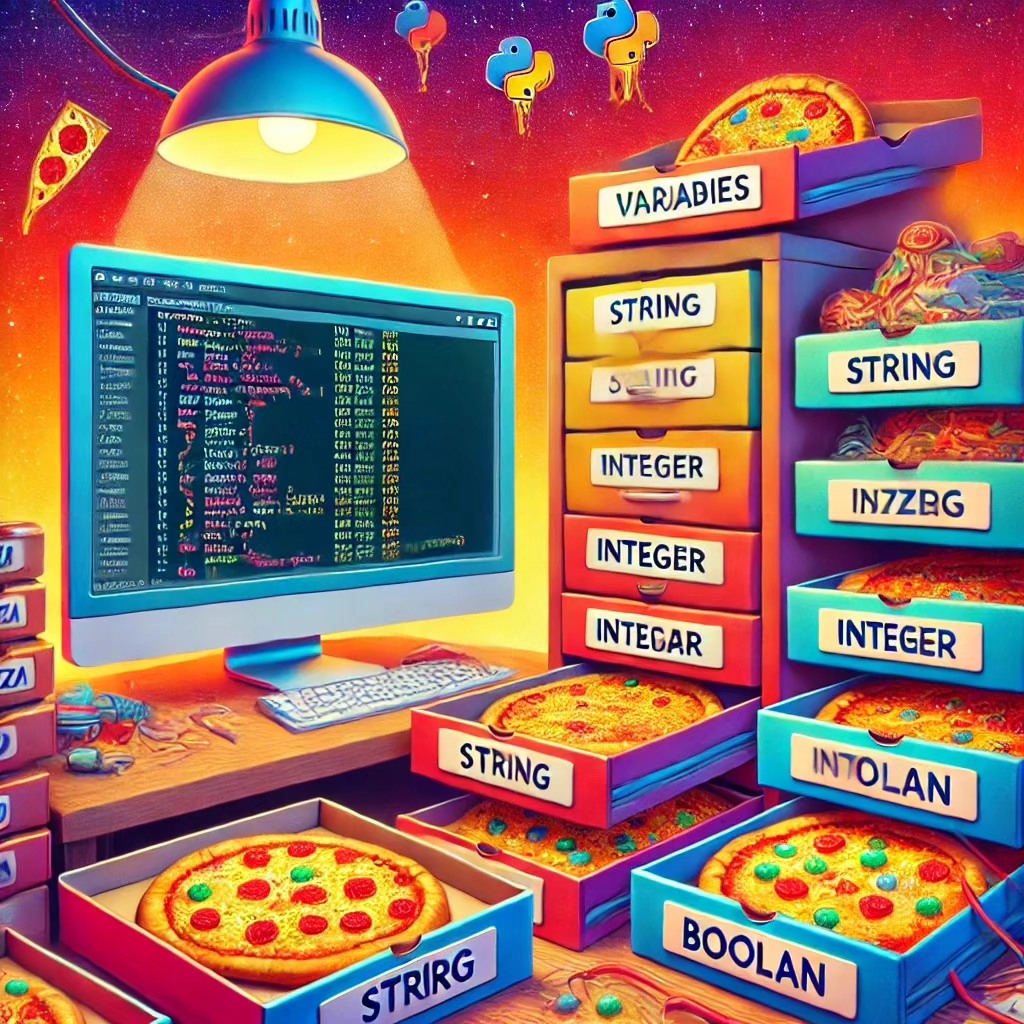
Lesson 2: Variables and Data Types - Why You Need to Know Where Your Pizza Is Stored!
Welcome back to the second lesson of our Python course! 🎉 After learning how to kickstart Python in our first session, today we’re diving into the magical world of variables and data types. Yeah, I know, it sounds a bit dull, but think of variables as magical boxes where you can store… well, anything, even pizza! 🍕
What Is a Variable?
Imagine you’ve got a piping hot pizza. Now, you need somewhere to put it, right? Well, in Python, a variable is that place. It’s like a magical container where you can put numbers, words, or virtual pizzas (sadly, not real ones yet).
Here’s how you create a variable in Python:
pizza = "Margherita"
Now, every time you type “pizza”, Python knows you’re talking about your Margherita pizza. Not bad, huh?
Data Types: But What Kind of Pizza Is It?
Now that you know what a variable is, let’s talk about data types. Variables can hold different kinds of “things.” It’s like the difference between a Margherita pizza and a Four Seasons pizza. Both are pizzas, but they’re made of different stuff.
Here are the main data types in Python:
Strings (
str): Text between quotes, like your favorite pizza:pizza = "Margherita"Integers (
int): Whole numbers. Like the number of pizza slices you can eat:pizza_slices = 8Floats (
float): Decimal numbers, like the price of a pizza ($9.99 maybe?):pizza_price = 9.99Booleans (
bool): True or False, like the question: “Is my pizza gone?”:pizza_gone = False
Assigning and Reassigning Variables: Changing the Pizza!
You can also change the value of a variable at any time. For example, if you decide to switch up your pizza choice:
pizza = "Pepperoni"
Now, whenever you say “pizza”, Python knows you want Pepperoni. It’s like having a waiter who always remembers your order!
Number Operations: The Math of Pizza 🍕
Python is also a powerful calculator. You can use it to do any kind of math operation. Here are some examples:
Addition (
+): How many pizzas did you order?pizzas_ordered = 2 + 3 # Result: 5Multiplication (
*): How many total slices of pizza do you have?total_slices = 8 * 5 # Result: 40 slices (a lot of pizza!)Division (
/): If you need to divide the pizza between friends:slices_per_friend = 8 / 4 # Result: 2 slices each
The Power of Variables: Save Time and Pizza!
The whole idea of using variables is simple: instead of writing the same number or text over and over again, you use a variable and change its value just once. Here’s an example:
pizza_slices = 8
people = 4
slices_per_person = pizza_slices / people
If you change the number of people or slices, Python will automatically update the value. It’s like having an assistant for your pizza party calculations! 🎉
Conclusion: The Magic of Pizza (and Variables)
Variables and data types are the foundation of any programming language, and Python is no different. Now, you can store your pizzas (and anything else) in variables, manipulate them, and create programs that do the math for you!
In the next lesson, we’ll explore lists, a fantastic way to store multiple pizzas in one “box.” Yes, it’s even better than it sounds!
Until next time, and happy coding with Python!
See also
- Lesson 6 – Event Delegation: Mastering Efficiency in Interaction
- Lesson 5 – Event Magic: Making Web Pages Interactive
- Lesson 4 – DOM Manipulation: Turning the Web into Your Personal Playground
- Lesson 2 – Loops and Conditionals: Making Decisions and Repeating Yourself (Without Going Crazy)
- Unlock the Power of JavaScript – A Beginner’s Journey (No Cape Required)